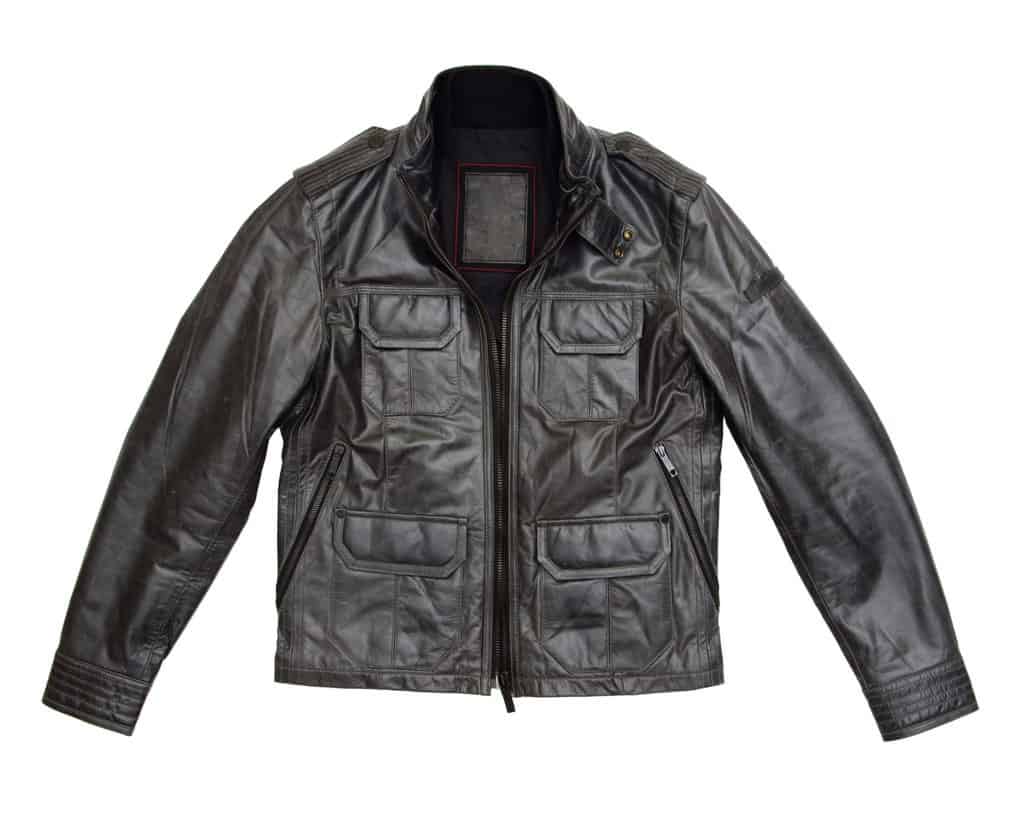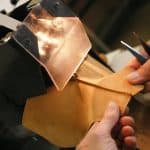You may have just bought a leather jacket and want to know if it can fit you better. It may be too small for you and you want a way to let it fit you better. We will teach you everything about stretching leather, the limits, as well as effective methods for stretching your leather jacket at home.
Can a leather jacket be stretched?
Yes, leather jackets can be stretched up until a certain point if you want to make them fit better. An XL wearer may never be able to stretch a size S to their size, but if it feels just a little bit too tight, stretching can be the key to a great fit.
Can a tailor make a leather jacket bigger?
We have answered this briefly in the FAQ section of our article about tailoring. However, we want to answer this in more detail here. Leather is much thicker than fabric, thus making it more difficult for the leather workers to leave large seam allowances to accommodate for resizing.

Take trousers as a comparison, fabric trousers usually have a large waist seam allowance at the back seam of the garment. This allows tailors to be able to take it apart and reveal those allowances and make the waist bigger.
If leather jackets had large seam allowances, it would show itself as an unsightly bulge around the seams, ruining the whole aesthetic of the jacket. Additionally, when leather is stitched, it leaves irreversible holes that will be obvious when resizing.
It is best to buy a leather jacket closest to your size, as close as you can and stretch or shrink the leather jacket as needed. If you want to shrink a leather jacket, we have written about this in detail in this article.
Do leather jackets stretch or shrink over time?
Leather jackets definitely do stretch over time. They won’t become oversized to the point of sagging, but the parts that get worked and stretched with normal wear will loosen up. Before we explain this further, here’s a very quick physics lesson.
Elastic deformation and plastic deformation
Elastic deformation is when a material is able to return to its original size without any signs of it being deformed. All materials can go through elastic deformation, up until a certain point. If it passes that point, it may not return to its original state and will stay stretched until it is deformed back to its original state.
We hope we didn’t bore you there, but going back to the main topic, leather can return to its original position, some types of leather have a higher plastic deformation threshold than others.
Suede and genuine leather have looser fibers and have a higher plastic deformation threshold because of their softer nature. Higher quality leathers like top-grain or full-grain leather have tighter fibers and are stiffer. They are more durable and harder to stretch, but they have a lower plastic deformation threshold.
Confusingly enough, however, leather jackets can also shrink over time. This happens when the leather dries out and the fibers tighten up due to the lack of moisture. When this happens, it is best to apply a leather conditioner to prevent it from cracking. Leather conditioners should be applied every 6-12 months to ensure the longevity of your leather items
How do you stretch a leather jacket?
Stretching your leather jacket is the only reliable way to make your leather jacket bigger as leather tailors won’t be able to do so. However, before you do any of the methods below, you should take into consideration the risks you might be putting your jacket in and the precautions you should take to avoid damaging your jacket.
Risks and precautions
The methods below will involve water and heat. These are generally not ideal things to expose your jacket to, but they can be used as a tool when handled correctly. Heat and moisture are two of the things that can strip the leather of its protective oils and expose it to water damage, drying out, and potentially cracking if not properly cared for after subjecting it to heat and moisture.
If the leather is soaked and is not properly dried out in a cool, dry room, the excess moisture may cause mold to form as well as water stains . These will manifest themselves as light or dark patches that may be very difficult to remove. Make sure to not leave any concentrations of moisture on the surface and don’t let it dry out too much before conditioning the leather.
Now that’s out of the way, here are the methods to stretch out your leather jacket and hopefully make it fit you better.
#1 Leather conditioning products
This is one of the easiest ways for you to stretch your leather jacket. Most brand new and authentic leather products come with a leather conditioner but if you don’t have one, you can purchase your own leather conditioner from retail stores or online. We reviewed some of the best leather cleaners and conditioners here..
Leather conditioners have oils to soften the fibers of your leather jacket thus, making it more flexible. It also comes with the added benefit of strengthening the leather and improving the texture and finish. This method may also be used on faux leather, but only real leather will absorb the conditioner.
Things you will need:
- Leather conditioner
- Soft sponge or cloth
- Leather cleaning brush (optional)
- CONDITIONS AND RESTORES: The refined water-based formula is blended with Vitamin E and Aloe extracts...
- DRY-TO-THE-TOUCH FORMULA: Once the surface is clean, spread Leather Conditioner with a microfiber...
- RESTORE WITH VITAMIN E & ALOE: Leather Conditioner is designed to maintain coated and natural...
Steps:
- Clean your leather jacket thoroughly using a brush or damp cloth before applying the product to remove any debris or dirt that may scratch the leather when applying the conditioner.
- Apply a decent amount of the leather conditioner on the entire jacket.
- Massage the leather material and carefully stretch it how you want it to fit.
- Wipe off any excess conditioner.
- Wear the leather jacket and move around to take advantage of the softness as it will slightly stiffen again once the conditioner is dry.
Tips and extra information:
- Make sure that you don’t overuse the leather conditioner.
- Avoid letting anything wet touch your material while conditioning.
- Some jackets that are made up of soft leather like goat or sheep skin can stretch out very easily while stronger leathers made from cowhide leather may take more time to stretch out.
#2 Submerging in warm water
Things you will need:
- Bowl
- Lukewarm water
- Sturdy hanger
- Soft cloth
Another quick method for stretching out your leather jacket is by using lukewarm water. Here’s a simple guide on how to do it:
Steps:
- Fill up a bowl with lukewarm water.
- Make sure that the bowl is big enough to submerge the whole jacket and leave it soaked for about 5-10 minutes.
- After a few minutes, wring out your leather jacket, but make sure not to squeeze too much as it can cause unwanted wrinkles on the material.
- Tug gently on the areas that are too tight as quickly as you can while the jacket is still warm.
- Repeat the last step until you get the fit that you want.
- Once you are done, hang your jacket and leave it to dry in a cool, dry room.
- Check on your leather jacket regularly, making sure that it is not becoming too dry.
- When sufficiently dry, apply a leather conditioner to avoid your leather jacket from drying out too much.
Tips and extra information:
- Be sure that the water is not too hot since your purpose of doing this is only to make the stretching process easier.
- Hanging the jacket as it dries will help it maintain its shape.
- Remember that leather is sensitive to water, so make sure not to leave it soaking more than the suggested time.
- Leaving the leather jacket to dry for too long can cause it to shrink as the moisture leaving the fibers will tighten it back up. It will also make the leather more prone to cracks and wrinkles. Really dry leather is also prone to water damage as it can quickly absorb any moisture on its surface.
#3 Stretching your leather jacket with steam
Steaming is one of the most efficient ways to manipulate leather, whether stretching or shrinking. We have mentioned this method in much detail in previous articles. We urge you to check out the steaming method in this article about getting wrinkles out of the leather jacket.
Wearing it
If you’re not up to doing any of these methods, don’t worry. Wearing the leather jacket can make it conform to your body shape over time. Assuming your leather jacket isn’t a very wrong size it can fit you perfectly in just a few days’ time if you wear it all the time.
If your leather jacket is new, you should check out our “How to Break in New Leather Jacket – 3 Best Ways” article which goes through what you should do to make your new leather jacket more comfortable.
Conclusion
You don’t always need a custom leather jacket or have an ideal body to make your leather jacket fit. Whether it’s a little bit too big or a little bit too small, the beauty of leather jackets is that it’s never the end and you can always do something to make it yours.
We hope this guide has taught you more about leather and how it works, as well as equip you with the knowledge on how to make your leather jacket more comfortable.
FAQ
Are leather jackets meant to be tight?
Leather jackets can often act like a second skin. However, if you feel like you’re suffocating or if you can’t zip your jacket up completely, it might be a little too tight. To find out more about how a leather jacket should fit, we have discussed this in a lot of detail in this article about tailoring your leather jacket.






